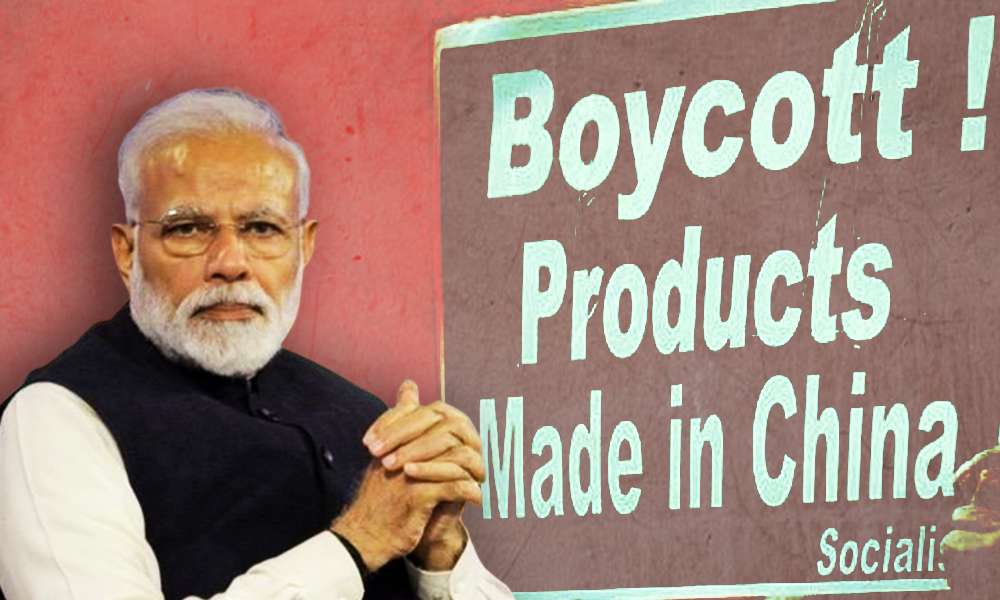When is ‘Boycott China’ possible?
When the economical gap between India and China is narrowed, the country, prompted by emotions of nationalism amid the standoff between the two countries, can boycott Chinese products and carve out a path for ‘Atma Nirbhar Bharat.’
‘Made in China’ label has over the years catapulted into every possible industry operating in India. This includes the well-known consumer durables comprising electronic goods, textile and garment industry, toys, medicines, car components but also encompass the Indian digital sector consisting of applications, OTT platforms, e-commerce companies and consumer fashion accessories etc.
Why is China cheaper?
Provision of cheap labour is one of the factors that contribute to cheaper Chinese products. Apart from labour, raw materials are a significant part of the total cost of the product. Since the Chinese firms invest in bulk purchases for bulk production, it saves the tremendous cost of production.
China is hailed as ‘the world’s factory’ because of the efficient business ecosystem comprising of a network of suppliers, component manufacturers, distributors, government agencies, and customers. All have key-roles to play in ironing out the production process.
Business loans are easily accessible, especially for bigger industries which provides a greater financial cushion to businesses in the manufacturing segment.
The Chinese factories have been criticized for their lower compliance with health and safety regulations and environmental protection laws.
China has been successful over the years in averting these additional costs which usually add to the companies’ expenditure bill.
Additionally, environmental protection laws are routinely ignored, enabling Chinese firms to cut down on waste management costs.
Next, China follows a Value Added Tax (VAT) system. A tax which is charged only on the ‘value-added’ to a product, material or service at every stage of its further manufacture or distribution.
Exported goods are subject to zero per cent VAT. In simpler terms, they enjoy a VAT exemption or rebate policy.
These factors aid in keeping the cost of production low, enabling the country to attract investors and companies looking to produce low-cost goods.
Also, technological advancement in terms of machinery and industrial resources eventually helps these factories in exporting products to other countries at a price that is either below the host country’s market price or its cost of production.
Why is ‘Made in China’ popular in India?
Chinese products have been successful in flooding the Indian market because the price of these goods is comparatively 10-70 per cent cheaper than Indian products.
Although durability and quality have always been the point of contention, several attributes such as bulk availability at lower prices and varieties to choose sidelines the of Chinese products in India.
The aforementioned factors make the Chinese goods attractive in the eyes of the Indian dealers and businessmen who ultimately seek profit from running a business.
Most importantly, no Indian is forced to buy Chinese products. Still, there is a considerable demand because the Chinese products offer more value for money than a locally manufactured product.
Why ‘Boycott Chinese Products’ Movement is difficult in India?
1. Understanding the trade deficit
Amid India’s limited production capabilities, China has emerged as the biggest importer of consumer products.
The trade deficit between the two countries is considered to be the largest among global trading partners with India importing seven times more than it exports to China.
In 2018-19, India’s exports to China were mere $16.7 billion, while imports were $70.3 billion, leaving a trade deficit of $53.6 billion.
As per the data quantified in the Indian government’s Ministry of Commerce and Trade website, China had a 5.08% share in India’s exports for the year 2018-19 and a 13.8% share in India’s imports for the year 2018-19.
Data suggests that China’s exports to India account for nearly 2-4 per cent of its total exports which it can afford to export to other countries, substituting India, and that would potentially not hurt China’s economy.
On the other hand, since India imports from China in large quantities, it will not be easy for India to find a replacement for Chinese goods at a comparatively low cost.
The task of mass-boycotting of Chinese products is feasible only when India has a substitute source which can match the cost and bulk-availability of Chinese products.
2. China is one of India’s key trading partners
According to an India Today report, India’s largest imports from China include electronics ($20 billion), nuclear reactors and machinery ($10.5 billion), chemicals ($6 billion) and steel ($2.3 billion).
Notably, after China, India’s largest imports come from the United States, Saudi Arabia and the UAE, a total of which reportedly acc…












